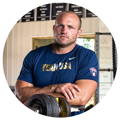Squat Alternatives
10 Squat Alternatives For Your Next Leg Day
“Never skip leg day.” If you are in the weight training world, this is a statement I am sure you are familiar with. And when we think leg day, do we think of other things besides squats? It doesn't matter, because this article is going to give you options other than squatting. YES, we love squats, and we will talk about why, but if for some reason you find yourself unable or unwilling to squat, we have your next leg day covered.
Why Squat?
Want to be strong, powerful, explosive, all of the above? Where do we sign up?! Well, if that's the case then you need to make sure you are prioritizing your squats. We squat to improve overall strength. The compound movement that is a squat helps knee extensors and flexors get stronger, more stable, stay healthy and arguably improve mobility. With squatting, you can put a decent load on your body and this in turn stimulates muscle adaptation, which is the whole purpose of training is it not? Aside from leg strengthening, squats also improve trunk control which we know is massive. Having solid dynamic trunk control allows you to be strong for all of your athletic goals. More often than not, there is no reason NOT to squat. But what happens if you can't? What happens if you don't have access or are unable to squat? Do you kiss your leg day gains goodbye?
When to Consider Squat Alternatives
You might find yourself reaching for this article and the 10 best squat alternatives for a few reasons. While we would love to be able to approach training and leg day with the intentions of loading a bar, placing it on our back and rocking leg day, there might be a few reasons why you wouldn't do that.
- Injury. While this is something we want to avoid, it happens from time to time. A strained groin or hamstring means we need to pump the brakes on squats for a few weeks, but it doesn't mean leg day gains go away. It means we pivot to an alternative.
- Mobility Limitations. Not uncommon for someone new to the gym, limitations in range of motion may prevent an athlete from hitting depth or having the ankle mobility to move in a way that is effective (let alone safe). Until the mobility issue is addressed and fixed, substituting squats for another movement might be the most effective approach on leg day. Some common squat mobility limitations could be seen in ankles, hips, and even thoracic spine.
- Lack of strength. Screaming from the rooftops, this is why dynamic trunk control is massively important. If your core is not stable, you can not effectively or safely load your spine to squat. Poor strength and stabilization will make it extremely difficult to maintain proper form. Also common is an underdeveloped posterior chain. Relying too much on the quads can lead to improper mechanics. We don't want to train and therefore get good at improper movement patterns. Once these strength issues are addressed, squatting might be more of a realistic leg day option.

Muscles Used In Squats
When we train squats, we are training so many different muscle groups. When trying to choose the appropriate squat day alternative, it's important to understand the priority with the squat, therefore understanding the muscle recruitment of the squat is helpful.
- Glutes. Your glutes are a “no duh” muscle when training squats. Most people understand that squats are a glute exercise. But remember, your glutes are actually composed of 3 muscles: the glute max, glute minimus and glute medius. So, when looking for an alternative that hits the same muscle groups, making sure each of the three glute muscles are trained is important.
- Quadriceps. A muscle that can often take over when squatting, the quadriceps extend the knee on the way up and control the knees on the way down. A muscle that is important in sport and physique alike, keeping in mind the quads when substituting for squats is important.
- Hamstrings. When looking for improvements in stabilization in squatting, the hamstrings come to mind. Along with their role in stabilization during a squat, hamstrings also work with the glute max for hip flexion and extension during a squat.
- Adductors. Similar to the hamstring, adductors help in stabilization during a squat, but they also provide a key role in initiating the squat. Strong adductors are something not to be overlooked in sport, as they are key in stability, coordination and balance. So, when looking for squat alternatives, don't sleep on also training your adductors.
- Hip Flexors. Squats require a stable pelvis. Your hip flexors are primary in stabilizing the pelvis in a squat and they also have a role in creating a stable foundation in general for your squat.
Now that we have a very basic idea of the muscles recruited and trained on your squat day, let's dive into some alternatives for your next no squat, leg day! In no particular order, here are 10 alternatives to keep in your arsenal of exercises.

10 Squat Alternatives Exercises
Split Stance Trap Bar Deadlift. With a big focus on hip extension in this movement, this exercise will recruit many of the same muscles that squatting does. While there is an emphasis on the quads, you will also feel your entire posterior chain, and core (depending on how heavy you load the bar), getting worked. With the split stance variation of the trap bar deadlift, depending on the rep schemes you choose, you will find you are not only strengthening the squat muscles but ultimately, they are leading to more impulse expression of your posterior chain.
Backwards Sled Pull. Want to blast your quads, specifically? Say no more, fam. Since we know that squatting recruits your quadricep muscles, when trying to target them specifically while also recognizing they won't be the only muscle recruited here, a backwards sled pull is king. This can also be a really great exercise to incorporate in training because the sled pull is hard to overdo, it is arguably a safer exercise than squatting, it is less demanding of the knees and an added bonus is that it gets your heart pumping.

Split Squats.Single leg movements are a great option to train many of the same muscles you use in the basic barbell squat. Your glutes, hamstrings and even quads and adductors to some extent will get worked when performing split squats. Depending on the foot position and angle of your torso, you can control the specific muscles you are trying to train. If you are looking specifically to light your hamstrings up a bit more, placing your front foot out further will do just the trick. Alternatively, looking to target glutes a bit more, then you will want your front foot to be slightly closer to your back foot while also slightly angling your torso forward. You will also notice your fair share of Dynamic trunk control recruitment in this exercise, which is similar to loading your spine with a bar to squat. Strong trunks help make strong athletes.

Reverse Hyper. Unique in that this is one of the few dynamic exercises, the reverse hyper will help you develop your posterior chain and increase your glute strength. With a focus on keeping your legs straight and maintaining a long pendulum throughout the movement, this exercise also requires dynamic trunk control which is similar to the training you would find in your squat day. While the reverse hyper machine isn't always something people have access to in training, if you do have access to it, this is your sign to get on that bad boy.
Nordic Curl. Really targeting hamstrings with the controlled eccentric is key. Adding the Nordic curl to your non squat leg day is an intense workout for your posterior chain and trunk. Performing the Nordic curl with a heavy focus on a super slow eccentric, up to 5 seconds, is a great way to increase overall leg strength. Incorporating Nordic curls in your training is a way to invest in your longevity in performance. Solid hamstrings and posterior chains can help athletes run faster, reduce injury and maintain balance.
Plyometrics and Sprints. Have you ever sprinted a 100m dash as fast as possible and then noticed the next day you are feeling it from such a short effort exercise? This is because things like sprinting and even plyometrics engage impulse expression. There is a large amount of force in a short period of time and that contributes to increased leg strength. A few other benefits of adding these movements to your squat alternatives include increased muscle output, faster muscle contractions and increased force in those muscle contractions. Clearly plyos and sprints are beneficial in a way similar to squats, but they also have their own unique benefits in training as well.
Spanish Squats. Grab a band and a kettlebell and get to working those quads. To be fair this is very much a squat however it's not a squat in the traditional sense. With the load not on your body rather something you hold and the addition of bands, this is quite different from what would typically be thought of when squatting. A Spanish squat can be a great squat alternative because of its emphasis on needing to control the amount the band pulls your knees forward right off the bat. As you are standing preparing to start the movement, you will notice your quads are already lighting up. The added component of a band allows you to train your squat muscles without the heavy load on your spine. While your quads will be a primary focus with this one, your trunk will also get in on the action as you try to maintain proper posture while holding the weight in front of your chest.
Lunges. When considering strength building exercises that produce results similar to squatting, walking lunges is a movement that you can do with either body weight or with the addition of weight. Holding weights in a suitcase hold or on the shoulders will slightly impact the muscles recruited, however any variation of the lunge will focus on improving hip mobility while strengthening hamstrings and glutes. Your adductors will also be recruited as you are working to stabilize that front leg, especially when under load. When adding weight to the front, shoulders or side, lunges can also contribute to dynamic trunk control strength and stability, which is similar to that of a squat as well.
Step Ups. A recent study confirms that if you are looking for glute max strength and development, the step up is superior. Step ups can be loaded in various ways giving you the opportunity to train other muscles similar to those recruited in a squat. This single leg exercise will not only improve your strength, but you will also be training balance, coordination and again that dynamic trunk control.
Barbell Hip Thrust.With the ability to put your glutes at terminal extension with a barbell hip thrust, you will find more motor recruitment of the glutes with this exercise. Driving through the heels, getting full hip extension and looking for a squeeze of the glutes and a slight hold at the top of this movement mimics that of your squat day training. Along with the movements being mimicked, you are also able to load the bar here with some considerable weight. Using this as a key squat day alternative is also in your favor because the specific muscles recruited are glutes, hamstrings, adductors, quads and trunk. Working all of these at the same time is extremely similar to that of a traditional weighted squat.

Lastly
If you want to be a strong, powerful, and explosive athlete, there is no room not to squat. Squatting, often multiple times a week, is critical in most any strength program. But we also recognize the fact that things happen. When injury, mobility or even equipment access throw you off of your game for a temporary period of time, it doesn't mean you need to kiss your squat producing gains goodbye. Nope. Instead, just be mindful of programming in a way that you are hitting each muscle the squat does and doing it with the right reps, sets and volume to get the adaptation you are looking for. Our Peak Strength app can help and guide you with just that.



Gaylemarie Kayes
Gaylemarie, but just call her GM, is a seasoned fitness and nutrition professional with nearly two decades of experience in the industry. With a diverse clientele ranging from ultra runners to high-level competitors, gm brings a wealth of knowledge and expertise. As a former high-level athlete in running, CrossFit and Olympic lifting to now, a busy yet active mother, she understands the challenges of balancing fitness and goal getting with a hectic lifestyle. Gm's approach emphasizes discipline, ownership, and hard work, tailored to honor each individual's life season for optimal health and well-being.
Blog Topics

Yo, It's Dane
Welcome to the Garage Strength Blog, where it is my goal to provide you with the experience and knowledge I've gained in the strength and conditioning world over many years of learning from both successes and failures. I train elite-level athletes in a multitude of sports from the high school to professional levels, already producing 5 Olympics and 30+ National Champions. If you want to be the next champion I train, check out my strength programs below!
Start Training With Me

Join for free educational videos EVERY WEEK on strength coaching and athletic performance

